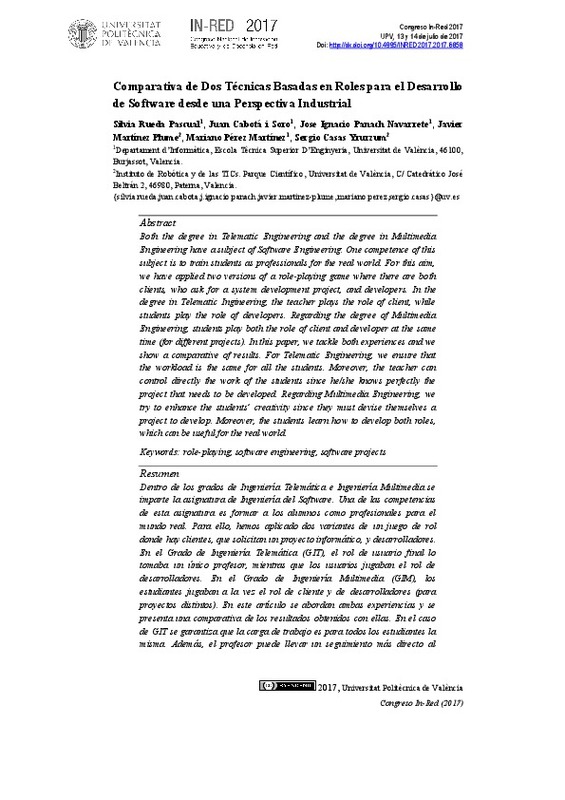JavaScript is disabled for your browser. Some features of this site may not work without it.
Buscar en RiuNet
Listar
Mi cuenta
Estadísticas
Ayuda RiuNet
Admin. UPV
Comparativa de Dos Técnicas Basadas en Roles para el Desarrollo de Software desde una Perspectiva Industrial
Mostrar el registro sencillo del ítem
Ficheros en el ítem
| dc.contributor.author | Rueda Pascual, Silvia
|
es_ES |
| dc.contributor.author | Cabotà, Juan
|
es_ES |
| dc.contributor.author | Panach Navarrete, Jose
|
es_ES |
| dc.contributor.author | Martínez, Javier
|
es_ES |
| dc.contributor.author | Pérez, Mariano
|
es_ES |
| dc.contributor.author | Casas, Sergio
|
es_ES |
| dc.date.accessioned | 2018-07-24T07:26:36Z | |
| dc.date.available | 2018-07-24T07:26:36Z | |
| dc.date.issued | 2017-07-18 | |
| dc.identifier.isbn | 9788490485682 | |
| dc.identifier.uri | http://hdl.handle.net/10251/106190 | |
| dc.description.abstract | [EN] Both the degree in Telematic Engineering and the degree in Multimedia Engineering have a subject of Software Engineering. One competence of this subject is to train students as professionals for the real world. For this aim, we have applied two versions of a role-playing game where there are both clients, who ask for a system development project, and developers. In the degree in Telematic Ingineering, the teacher plays the role of client, while students play the role of developers. Regarding the degree of Multimedia Engineering, students play both the role of client and developer at the same time (for different projects). In this paper, we tackle both experiences and we show a comparative of results. For Telematic Engineering, we ensure that the workload is the same for all the students. Moreover, the teacher can control directly the work of the students since he/she knows perfectly the project that needs to be developed. Regarding Multimedia Engineering, we try to enhance the students’ creativity since they must devise themselves a project to develop. Moreover, the students learn how to develop both roles, which can be useful for the real world. | es_ES |
| dc.description.abstract | [ES] Dentro de los grados de Ingeniería Telemática e Ingeniería Multimedia se imparte la asignatura de Ingeniería del Software. Una de las competencias de esta asignatura es formar a los alumnos como profesionales para el mundo real. Para ello, hemos aplicado dos variantes de un juego de rol donde hay clientes, que solicitan un proyecto informático, y desarrolladores. En el Grado de Ingeniería Telemática (GIT), el rol de usuario final lo tomaba un único profesor, mientras que los usuarios jugaban el rol de desarrolladores. En el Grado de Ingeniería Multimedia (GIM), los estudiantes jugaban a la vez el rol de cliente y de desarrolladores (para proyectos distintos). En este artículo se abordan ambas experiencias y se presenta una comparativa de los resultados obtenidos con ellas. En el caso de GIT se garantiza que la carga de trabajo es para todos los estudiantes la misma. Además, el profesor puede llevar un seguimiento más directo al conocer de primera mano el caso a desarrollar. En el caso de GIM se potencia la creatividad de los alumnos, ya que deben inventarse el proyecto a desarrollar. Además, los alumnos aprenden a desempeñar dos roles que les pueden ser útiles en el mundo real. | es_ES |
| dc.description.sponsorship | Este trabajo se ha desarrollado dentro del proyecto de innovación educativa “Desarrollo de Software desde una Perspectiva Industrial” de la Universidad de Valencia. | es_ES |
| dc.format.extent | 12 | es_ES |
| dc.language | Español | es_ES |
| dc.publisher | Editorial Universitat Politècnica de València | es_ES |
| dc.relation.ispartof | In-Red 2017. III Congreso Nacional de innovación educativa y de docencia en red. | es_ES |
| dc.rights | Reconocimiento - No comercial - Sin obra derivada (by-nc-nd) | es_ES |
| dc.subject | Educación superior | es_ES |
| dc.subject | Enseñanza superior | es_ES |
| dc.subject | Tecnologías y educación | es_ES |
| dc.subject | Innovación educativa | es_ES |
| dc.subject | Juego de roles | es_ES |
| dc.subject | Ingenieria del software | es_ES |
| dc.subject | Proyecto software | es_ES |
| dc.title | Comparativa de Dos Técnicas Basadas en Roles para el Desarrollo de Software desde una Perspectiva Industrial | es_ES |
| dc.type | Capítulo de libro | es_ES |
| dc.type | Comunicación en congreso | es_ES |
| dc.identifier.doi | 10.4995/INRED2017.2017.6858 | |
| dc.rights.accessRights | Abierto | es_ES |
| dc.description.bibliographicCitation | Rueda Pascual, S.; Cabotà, J.; Panach Navarrete, J.; Martínez, J.; Pérez, M.; Casas, S. (2017). Comparativa de Dos Técnicas Basadas en Roles para el Desarrollo de Software desde una Perspectiva Industrial. En In-Red 2017. III Congreso Nacional de innovación educativa y de docencia en red. Editorial Universitat Politècnica de València. 552-563. https://doi.org/10.4995/INRED2017.2017.6858 | es_ES |
| dc.description.accrualMethod | OCS | es_ES |
| dc.relation.conferencename | IN-RED 2017: III Congreso Nacional de Innovación Educativa y Docencia en Red | es_ES |
| dc.relation.conferencedate | Julio 13-14,2017 | es_ES |
| dc.relation.conferenceplace | Valencia, Spain | es_ES |
| dc.relation.publisherversion | http://ocs.editorial.upv.es/index.php/INRED/INRED2017/paper/view/6858 | es_ES |
| dc.description.upvformatpinicio | 552 | es_ES |
| dc.description.upvformatpfin | 563 | es_ES |
| dc.type.version | info:eu-repo/semantics/publishedVersion | es_ES |
| dc.relation.pasarela | OCS\6858 | es_ES |
| dc.contributor.funder | Universitat de València |








